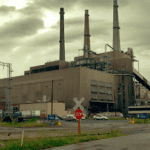Coal-fired power generation has taken another punch, as Consumers Energy—which along with DTE Energy supplies most of Michigan’s power—has announced it will phase out coal burning over the next two decades, with a plan to generate at least 40% of its electricity from renewable sources by 2040.
Patti Poppe, Consumers’ president and CEO, made the announcement on February 19. She said the Jackson, Michigan-based utility will supplant its coal-fired power with continued use of natural gas and hydropower, increased reliance on renewables, and better efficiency measures.
“We believe that climate change is real and we can do our part by reducing our greenhouse gas emissions, and we also believe it doesn’t have to cost more to do it,” Poppe said Monday. “We believe we’re going to be on the right side of history on this issue.”
DTE Also Retiring Coal Units
Detroit-based DTE, the state’s largest power supplier, in May of last year made a similar announcement, saying it plans an 80% cut in carbon emissions by 2050, helped by phasing out its remaining coal-fired power by 2040. The utility already plans to retire eight coal-fired units at three plants between 2020 and 2023, with just six coal-fired units operating after that. DTE in August 2017 announced it would build a new 1,100-MW gas-fired plant northeast of Detroit.
DTE’s $15 billion plan calls for an eventual portfolio of 40% gas-fired power, 40% renewable energy—mostly from a large increase in wind power—and 20% from nuclear, from the company’s 1,170-MW Fermi 2 plant in Newport, Michigan. Fermi 2 came online in 1988. Its operating license was renewed by the U.S. Nuclear Regulatory Commission in late 2016, allowing the plant to operate into 2045, at which time it could be renewed again.
Michigan lawmakers in 2016 established new energy rules, which call for DTE and Consumers to generate or purchase at least 15% of their electricity from renewable sources by the end of 2021. The new legislation increased the previous renewable energy standard of 10%.
Monday’s announcement adds to the total of U.S. coal-fired units disappearing from the nation’s fleet that have either retired or have announced closures since 2010. According to the Sierra Club—and prior to the Consumers’ announcement Monday—at least 268 coal-fired plants have either retired or have announced closures since 2010.
Coal Plant Closures Continue
FirstEnergy on February 16 said it would close the 1,300-MW Pleasants Power Station in West Virginia, unless a buyer can be found by year-end. Vistra Energy subsidiary Luminant shuttered its 1,150-MW Big Brown plant in Texas this month, a closure announced in October 2017. Last week, Talen Energy and the Sierra Club reached a settlement to phase out coal burning at Talen’s Brunner Island plant in Pennsylvania; the plant—honored as a POWER Top Plant in 2010—can continue to burn natural gas.
Consumers expects to file a resource plan with the Michigan Public Service Commission (PSC) by June of this year, outlining the timetable for retiring its remaining coal units and increasing its natural gas-fired and renewable generation. The PSC then would need to approve the plan. Consumers already has retired much of its coal fleet, closing seven units on April 15, 2016–the most of any U.S. utility in that year. The utility has five coal-fired units still in operation, with a total generation capacity of about 1,960 MW.
Consumers Energy owns two wind turbine farms in Michigan and buys power from a third, and with DTE is co-owner of a hydropower plant on Lake Michigan. Poppe on Monday said, “We don’t have to make a sucker’s choice of either affordable prices or clean energy. We can do what’s right for the planet and the customers we serve. We don’t think there’s a trade-off to be made here.”
—Darrell Proctor is a POWER associate editor (@DarrellProctor1, @POWERmagazine)










